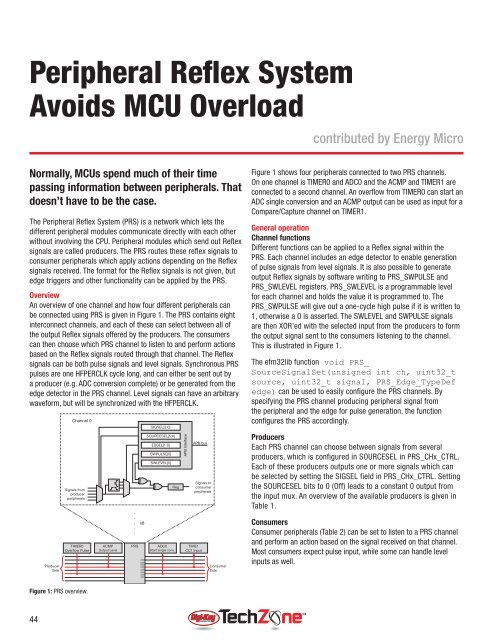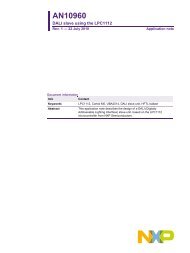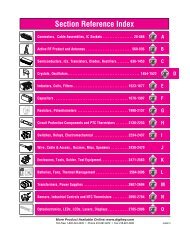Microcontroller Solutions TechZone Magazine, April 2011 - Digikey
Microcontroller Solutions TechZone Magazine, April 2011 - Digikey
Microcontroller Solutions TechZone Magazine, April 2011 - Digikey
You also want an ePaper? Increase the reach of your titles
YUMPU automatically turns print PDFs into web optimized ePapers that Google loves.
Peripheral Reflex System<br />
Avoids MCU Overload<br />
contributed by Energy Micro<br />
Normally, MCUs spend much of their time<br />
passing information between peripherals. That<br />
doesn’t have to be the case.<br />
The Peripheral Refl ex System (PRS) is a network which lets the<br />
different peripheral modules communicate directly with each other<br />
without involving the CPU. Peripheral modules which send out Refl ex<br />
signals are called producers. The PRS routes these refl ex signals to<br />
consumer peripherals which apply actions depending on the Refl ex<br />
signals received. The format for the Refl ex signals is not given, but<br />
edge triggers and other functionality can be applied by the PRS.<br />
Overview<br />
An overview of one channel and how four different peripherals can<br />
be connected using PRS is given in Figure 1. The PRS contains eight<br />
interconnect channels, and each of these can select between all of<br />
the output Refl ex signals offered by the producers. The consumers<br />
can then choose which PRS channel to listen to and perform actions<br />
based on the Refl ex signals routed through that channel. The Refl ex<br />
signals can be both pulse signals and level signals. Synchronous PRS<br />
pulses are one HFPERCLK cycle long, and can either be sent out by<br />
a producer (e.g. ADC conversion complete) or be generated from the<br />
edge detector in the PRS channel. Level signals can have an arbitrary<br />
waveform, but will be synchronized with the HFPERCLK.<br />
Producer<br />
Side<br />
Channel 0<br />
Signals from<br />
producer<br />
peripherals<br />
TIMER0<br />
Overflow Pulse<br />
ACMP<br />
Output Level<br />
.<br />
.<br />
.<br />
.<br />
.<br />
PRS<br />
x8<br />
SIGSEL[2:0]<br />
SOURCESEL[5:0]<br />
EDSEL[1:0]<br />
SWPULSE[0]<br />
SWLEVEL[0]<br />
ADC0<br />
Start single conv.<br />
Reg<br />
APB bus<br />
Signals to<br />
consumer<br />
perpherals<br />
TIME1<br />
CC1 Input<br />
Consumer<br />
Side<br />
Figure 1 shows four peripherals connected to two PRS channels.<br />
On one channel is TIMER0 and ADC0 and the ACMP and TIMER1 are<br />
connected to a second channel. An overfl ow from TIMER0 can start an<br />
ADC single conversion and an ACMP output can be used as input for a<br />
Compare/Capture channel on TIMER1.<br />
General operation<br />
Channel functions<br />
Different functions can be applied to a Refl ex signal within the<br />
PRS. Each channel includes an edge detector to enable generation<br />
of pulse signals from level signals. It is also possible to generate<br />
output Refl ex signals by software writing to PRS_SWPULSE and<br />
PRS_SWLEVEL registers. PRS_SWLEVEL is a programmable level<br />
for each channel and holds the value it is programmed to. The<br />
PRS_SWPULSE will give out a one-cycle high pulse if it is written to<br />
1, otherwise a 0 is asserted. The SWLEVEL and SWPULSE signals<br />
are then XOR’ed with the selected input from the producers to form<br />
the output signal sent to the consumers listening to the channel.<br />
This is illustrated in Figure 1.<br />
The efm32lib function void PRS_<br />
SourceSignalSet(unsigned int ch, uint32_t<br />
source, uint32_t signal, PRS_Edge_TypeDef<br />
edge) can be used to easily confi gure the PRS channels. By<br />
specifying the PRS channel producing peripheral signal from<br />
the peripheral and the edge for pulse generation, the function<br />
confi gures the PRS accordingly.<br />
Producers<br />
Each PRS channel can choose between signals from several<br />
producers, which is configured in SOURCESEL in PRS_CHx_CTRL.<br />
Each of these producers outputs one or more signals which can<br />
be selected by setting the SIGSEL field in PRS_CHx_CTRL. Setting<br />
the SOURCESEL bits to 0 (Off) leads to a constant 0 output from<br />
the input mux. An overview of the available producers is given in<br />
Table 1.<br />
Consumers<br />
Consumer peripherals (Table 2) can be set to listen to a PRS channel<br />
and perform an action based on the signal received on that channel.<br />
Most consumers expect pulse input, while some can handle level<br />
inputs as well.<br />
Figure 1: PRS overview.<br />
44














